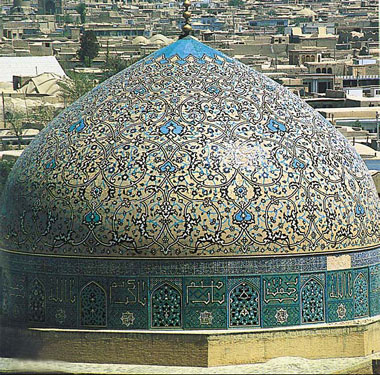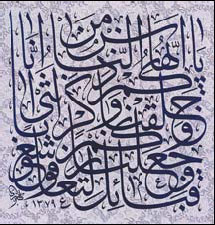Artistic splendor
Handicrafts
|
Iranian historical architecture is well known for its use of domes, arches and beautiful decoration. |
Iranian handicrafts represent a native and independent industry as well as the most important applied art of the country.
Iranian craftsmen have in fact safeguarded this popular art through the centuries by creating various handicraft masterpieces, which now adorn many famous museums and art centers, and have won the attention and admiration of critics and connoisseurs of art and culture.
According to technique of production, Iranian handicrafts can be classified into various categories: handloom weaving, handwoven textile (traditional textile), knitting, traditional embroidery, traditional printing, felt making, pottery and ceramics, glass work, leather and fur products, metal work and alloy, chiseling, fretwork, engraving on metals and alloy, stone sculpture, wood turning, elaborate woodwork and finishing, relief-work, carving and fretwork on wood, mat weaving, marquetry, inlay-work, tile-work, filigree work, enamel-work, creating decorative and artistic works, ornament making, and production of other traditional items.
Carpets
|
Iranian cuisine |
When speaking of carpets, Iran is the first name that springs to mind. It is generally acknowledged that some of the world's finest and most sumptuous carpets are woven in Iran.
To look at a Persian carpet is to gaze into a world of artistic magnificence nurtured for more than 2,500 years. The Iranians were among the first carpet weavers of ancient times.
Persian rugs are generally handwoven by skilled artisans. The craft varies from region to region depending on the environment and lifestyle of the rug makers.
Art experts around the world compare the Iranian carpet to a multicolored pleasant garden, full of flowers and trees, different types of birds and animals, legendary creatures, scenes of hunting grounds and intricate design, which bestow a breathtaking beauty to Iranian carpets.
These carpets possess at once the three qualities of fineness, elegance and durability, and for these reasons are unique in the world.
In ancient times, Persian carpets were exchanged among kings of different lands as precious gifts. Europeans have appreciated the beauty of this work of art and used it in their homes for centuries.
History reveals that Persian carpets were brought to East Asia via the Silk Road. The beauty, magnificence of design, colors and originality of Persian carpets have never stopped fascinating people around the world.
Architecture
|
Calligraphy is one of Iran's renowned art forms. |
Architecture is one of the fields in which Iranians have excelled for centuries. Iran ranks among the top 10 nations with the most architectural ruins from antiquity and is recognized by UNESCO as being one of the cradles of ancient civilization.
Iranian historical architecture is well known for its use of domes, arches and beautiful decoration. The major building types of this architecture are the mosque and the palace. The architecture makes use of abundant symbolic geometry, using pure forms such as the circle and square. Plans are often based on symmetrical layouts featuring rectangular courtyards and halls.
The post-Islamic architecture of Iran draws ideas from its pre-Islamic predecessor, and features geometrical and repetitive forms as well as surfaces richly decorated with glaze tiles, carved stucco, patterned brickwork, floral motifs, and calligraphy.
Calligraphy
|
Persian carpets woven in Iran possess the three qualities of fineness, elegance and durability. |
The art of calligraphy is one of the reputable and famous arts of Iran.
The glorious art of calligraphy and its numerous decorations have always won praise.
The importance of the art of calligraphy among Iranian arts is such that some arts seem to be incomplete without decorative calligraphy.
Iranians more than any other nation have used calligraphy in various forms to enrich and beautify earthenware, metallic vessels and historic buildings.
Most of the handwritten books of Iran, specially the Holy Quran, and collections of poems such as Shahnameh, Hafez, Golestan, Boostan and Khayam have been recognized as precious artistic works because of their graceful and delicate calligraphy.
These books possess extraordinary value and importance for art experts all around the world.
The works of Iran's calligraphers are preserved as precious artistic works in museums and private collections all across the globe.
The art of calligraphy in Iran has a long history. This history includes the position of writing in Iran and its process of evolution from the ancient times till the Islamic period and from that period to the present time.
A tablet in hieroglyphic discovered in the north-western part of the Iranian plateau, is a sign that the early inhabitants of Iran possessed inscriptive signs and methods. In archaeological searches of Silak and Marlik, dishes and cylindrical seals engraved with the very first Iranian writings have been discovered. Russian Orientalist M. Diacono has called these documents holy writings and believes that they belong to the end of the 4th and the beginning of the 3rd millennium BC.
(China Daily 02/18/2008 page16)


















